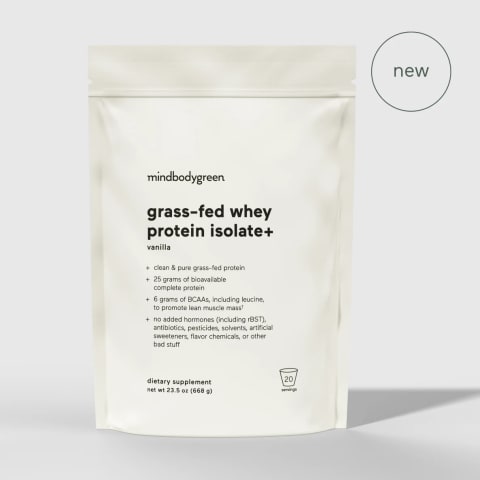Advertisement
How To Choose A Protein Powder You Actually Enjoy Drinking


Protein powders: Some people love them, while others have been burned by them. What group you fall into really comes down to the type of protein and the overall quality of the formulation. But it's hard to decipher from the seemingly thousands of options out there which one is the best. And unfortunately, not very many are crafted with care for optimal taste, texture, and health benefits. (This is the main reason we formulated our own: grass-fed whey protein isolate+.)
To reap the benefits of protein powders (think meeting your daily protein needs, building lean muscle, balancing blood sugar, and losing fat), you have to stay consistent with it.* That's near impossible if you don't like what you're consuming.
Here, we're going to break down some of the most common complaints about protein powders that we've heard over the years and offer easy solutions for finding one that works for you.
Problem: I always experience gas and bloating
This is something I've heard many times as a dietitian. And I find that people are always quick to blame whey protein for this. For those with lactose intolerance, it can be. However, other ingredients like sugar alcohols and thickening agents may also be the culprit of gas and bloating. These additives are both linked to gas and bloating, especially when consumed in high amounts.
Solution: If you have a sensitive stomach but still want all the benefits of an animal-based protein powder, then look for a whey isolate. Whey isolate is about 90 to 95% protein and less than 1% lactose1 (while whey concentrate is only about 70-80%2 protein and has slightly more lactose than whey isolate).*
You also want to look for options that don't have sugar alcohols (including sorbitol, mannitol, erythritol, maltitol, and xylitol) and thickeners (like xanthan gum).
Problem: It tastes overly sweet and chalky
Lots of protein powders are labeled "sugar-free," as they contain low- or no-calorie sweeteners. These could be the sugar alcohols we mentioned above, artificial sweeteners (sucralose, aspartame, or saccharin), stevia, or monk fruit.
Sometimes, multiple types of sweeteners are in the same formula to try to mask the chalkiness of the concentrated protein source. Add some artificial flavoring, and the protein starts to taste sickly sweet with an odd, lingering aftertaste.
Solution: Look for protein powders that are only lightly sweetened, preferably with monk fruit, stevia (although some people don't like the aftertaste it leaves), or organic vanilla. And avoid artificial flavors.
A high-quality protein powder should never taste chalky, which may happen if the powder clumps together. High-quality brands should ensure that the powder disperses readily in liquid with proper mixing. If it doesn't and you see it clumping together, shake it thoroughly in a shaker, use a frothing device, or blend it into a smoothie.
Our grass-fed whey protein isolate+ is flavored with pink Himalayan salt, organic monk fruit extract, organic cinnamon, organic bamboo extract, and organic vanilla extract or organic cocoa. The result is a light, fluffy powder that disperses quickly and easily in any liquid—hot or cold.*
Problem: My protein doesn't mix well in hot liquids
Some people prefer mixing their protein with a hot beverage, like coffee. But you may notice the protein powder clumping together, even after being stirred.
Solution: Use a handheld frother to help fully disperse the powder in the liquid. This helps create a smooth, rich texture. But some formulas mix in hot liquids better than others. For example, our grass-fed whey protein isolate+ mixes beautifully in hot coffee, acting as a chocolate or vanilla creamer with a hint of cinnamon.
Problem: It creates an overly frothy texture
We've talked a lot about making sure your protein powder is mixed into a liquid before consuming it. But when this happens, air is incorporated, potentially creating a foamy beverage. This by no means is a sign that something is wrong. Think about it: If you shake milk or froth milk for a latte, it creates foam because it's incorporating air. While some people love this attribute (it can create a milkshake-like consistency), others would rather minimize this attribute.
Solution: You also want to ensure your protein powder is well dispersed (stirred, shaken, or blended) into your food or beverage of choice. But you don't have to overdo it. If you're blending a big smoothie with lots of fruits and vegetables, consider adding everything but the protein powder and thoroughly blending. Then add the protein powder at the end and give it a few good pulses.
Problem: I think my protein powder is contributing to uneven skin
Not everyone experiences skin blemishes from a protein powder. But for those with a genetic predisposition, dairy-based products3 may be a potential contributing factor.
Solution: If you feel like you have this sensitivity to whey or casein, a plant protein or even a collagen powder may be a better fit. Supplementing with collagen supports skin elasticity4, hydration5, and the appearance of fine lines6. Here's a complete list of our top collagen powder recommendations. It's just important to note collagen has a very different amino acid profile than plant or animal protein and is not a complete protein.
The takeaway
Gone are the days when the only protein supplements available were canisters of chalky powders intended for being guzzled post-workout. If you find a high-quality protein powder, consuming it should be a delicious addition to your day and something you look forward to rather than dread.
6 Sources
Watch Next
Enjoy some of our favorite clips from classes
Enjoy some of our favorite clips from classes
What Is Meditation?
Mindfulness/Spirituality | Light Watkins
Box Breathing
Mindfulness/Spirituality | Gwen Dittmar
What Breathwork Can Address
Mindfulness/Spirituality | Gwen Dittmar
The 8 Limbs of Yoga - What is Asana?
Yoga | Caley Alyssa
Two Standing Postures to Open Up Tight Hips
Yoga | Caley Alyssa
How Plants Can Optimize Athletic Performance
Nutrition | Rich Roll
What to Eat Before a Workout
Nutrition | Rich Roll
How Ayurveda Helps Us Navigate Modern Life
Nutrition | Sahara Rose
Messages About Love & Relationships
Love & Relationships | Esther Perel
Love Languages
Love & Relationships | Esther Perel
What Is Meditation?
Box Breathing
What Breathwork Can Address
The 8 Limbs of Yoga - What is Asana?
Two Standing Postures to Open Up Tight Hips
How Plants Can Optimize Athletic Performance
What to Eat Before a Workout
How Ayurveda Helps Us Navigate Modern Life
Messages About Love & Relationships
Love Languages
Advertisement

This Little-Known Supplement Helps Women Sleep & Decreases Signs Of Depression
Molly Knudsen, M.S., RDN

This Little-Known Supplement Helps Women Sleep & Decreases Signs Of Depression
Molly Knudsen, M.S., RDN
















